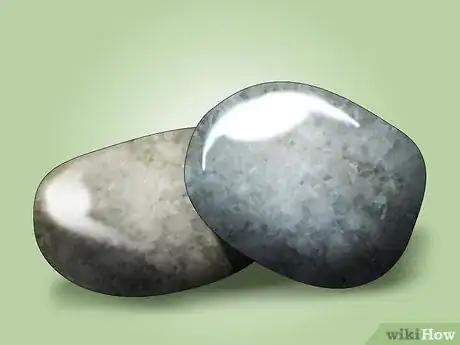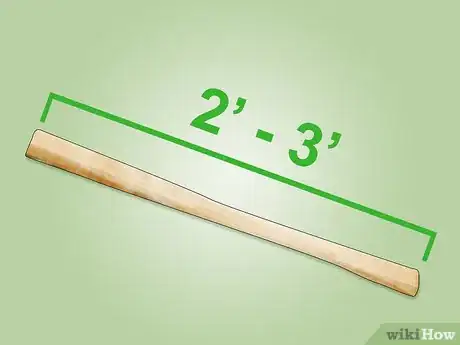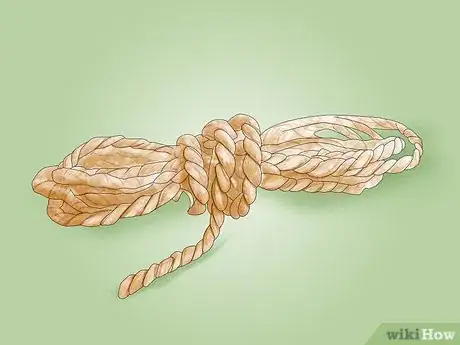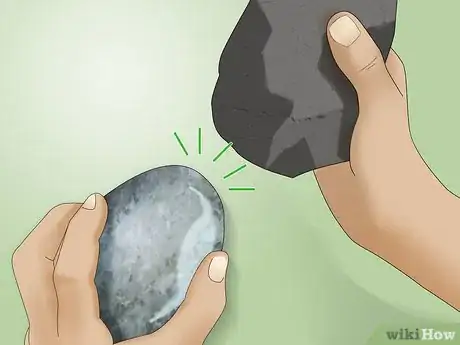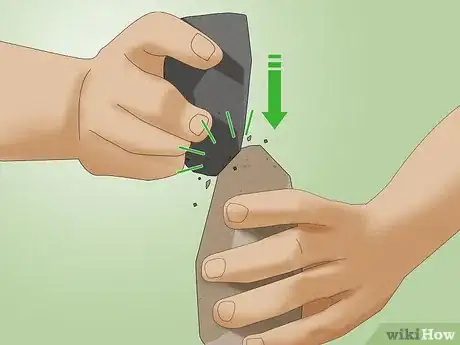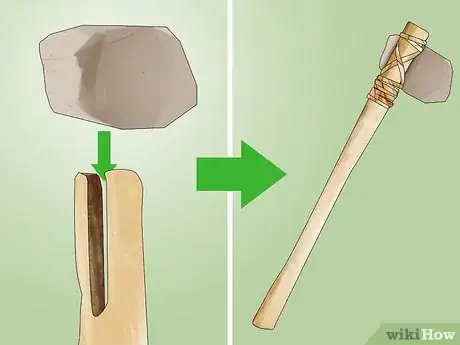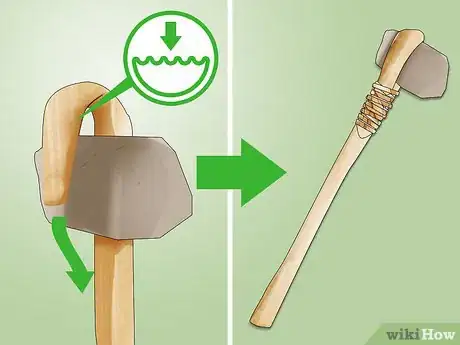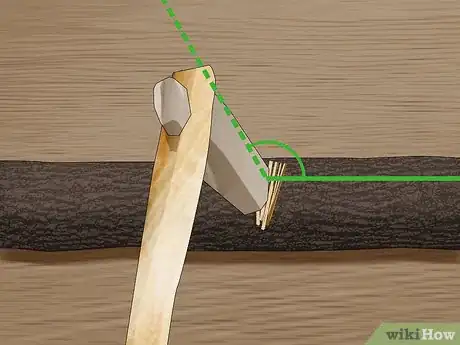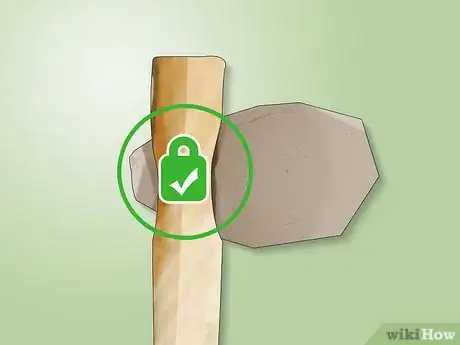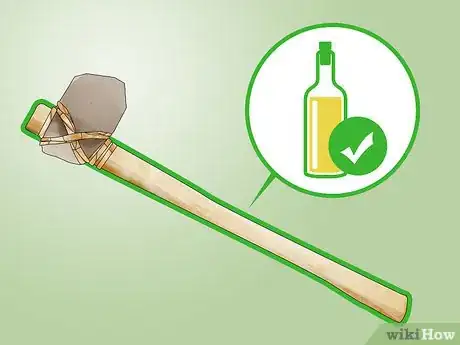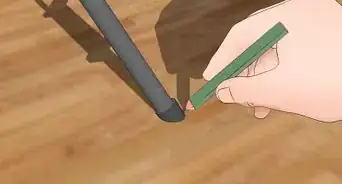This article was co-authored by wikiHow Staff. Our trained team of editors and researchers validate articles for accuracy and comprehensiveness. wikiHow's Content Management Team carefully monitors the work from our editorial staff to ensure that each article is backed by trusted research and meets our high quality standards.
wikiHow marks an article as reader-approved once it receives enough positive feedback. In this case, 100% of readers who voted found the article helpful, earning it our reader-approved status.
This article has been viewed 167,678 times.
Learn more...
Whether you’re making a stone axe to display for your class or making a working one to get in touch with survivalist techniques, it can be a handy and durable tool. Remember to use proper care and precautions when storing and using your tool. If a stone axe is used incorrectly, it can cause serious injury.
Steps
Gathering Your Materials
-
1Find a large rock with perpendicular edges. Look for a large rock on the edge of a stream or a river, also known as slab rocks. Avoid porous rocks that have holes or cavities in them, as well as rocks that have cracks. A solid rock with no visible flaws, preferably long and thick, is what you want to use for your axe. This will make it easier to pound at the edges of the rock without injuring your fingers, hands, or other body parts.[1]
- You will also need to find a large hammering rock, which you will use to shape the source rock. Look for a hammering rock that you can hold comfortably in your hand, with an even rock face. Using this method will create a knapped axe head, where the axe head is shaped by hitting it with another rock.[2]
-
2Use a river rock. Another option is to use a river rock that is hard and contains fine grained stone. Many river rocks are rounded in shape and smooth to the touch, unlike slab rocks, which are often jagged and square shaped. You can find river rocks at the bottom of the river or lining a stream. Look for a river rock that is relatively close to the size you’d like to have for your axe.[3]
- You will also need a hammering rock to slowly peck away at the river rock until it is shaped into a suitable axe. A quartzite rock would make an ideal hammering rock for your river rock axe head. This will create a pecked stone axe head, where the river rock is chipped at very slowly, or pecked, with another rock.
Advertisement -
3Look for freshly harvested or “green” wood. The handle for your stone axe will need to be made of freshly harvested wood, or wood that is from a young tree. This will ensure the wood can be bent and shaped without breaking. Privet stem is ideal, if available. You can also use wood from a small, young tree.[4]
- You will need a piece of “green” wood that is at least two to three feet long. Look for a piece of wood that is not too wide or too narrow. The handle should be wide enough to accommodate the axe head, but narrow enough to hold in your hand.
- You can try out the length of the wood by holding it in your hand. You want the axe to be long enough to hold comfortably and swing behind you.
-
4Get cord made of bark or wet rawhide. You will need strong cord to secure the stone axe head to the axe handle. You can find cord made of bark at outdoor supply stores. Wet rawhide can also be found in outdoor supply stores.
Shaping and Sharpening the Axe Head
-
1Hit the source rock with the hammering rock. Before you can shape the axe head, you will need to hit off a piece of the source rock that will become your axe head. Strike the upper edge of the source rock with the large hammer. Focus on striking off flakes and slabs of rock as you hit the source rock. Use short, swift hits against the source rock, lifting your arm a few feet from the source rock and coming down steadily with the hammering rock.[5]
- You can attempt to hit off a large slab that can be used as your axe head or hit down the source rock until it becomes the right size for the axe head. Be careful as you hit the source rock, as shards of rock will likely fly around. It is better to work slow and steady here so you do not have chunks of rock flying around you.
- For safety purposes, you may want to wear safety gloves and safety googles to protect yourself from flying rock shards.
- The goal is to have an axe head that is the size of your palm or a bit larger. Be patient, as it may take several hours to hit down the source rock until it is the ideal size for the axe head.
-
2Peck the river rock with the hammering rock. If you are using a river rock, you will need to take your time when pecking it down with the hammering rock. The grains of the river rock must be removed slowly as you can damage or split the rock if you are not careful. Work on one small area of the rock at a time and use short, swift strokes to carefully peck away at the river rock.[6]
- It can take several hours to peck away at the river rock. You should work outdoors in a comfortable area.
- Be careful of small pieces of river rock flying toward you as you peck the rock. If you work slow and steady, they should not be a major hazard.
-
3Form the cutting edge of the axe head. Once you have hit or pecked down the rock until it is about the size of your palm, you will need to form the cutting edge of the axe head so it is sharp. The axe head should taper down toward the cutting edge. The cutting edge should be a similar thickness to a steel axe, with a narrow edge.[7]
- Hold the axe head so it is vertical, resting on the wide side of the rock. Use the hammering rock to form a narrow end of the axe head by hitting the rock in small, short movements. You want this end to dip down so it forms a narrow edge. This edge will become the cutting edge of the axe head.
-
4Polish and sharpen the axe head on a stone with water. Polishing the rock will help it to stay durable and sharp. You can use the leftover source rock if there is a slab that is thick enough and wide enough to rub the axe head against it. Alternatively, you can look for a large flat piece of rock that has an even surface, as this will act as your polishing rock.[8]
- Pour a handful of water on the stone and start to rub the wide, flat side of the axe head against the stone. Use both hands to rub the stone back and forth, making sure to keep the polish rock wet with water.
- Polish down all sides of the axe head so it appears even and smooth on all sides. This could take a couple of hours so be patient and take your time.
- You may also want to use a smaller rock to polish the cutting edge of the rock. Make sure the axe head is wet as you use the small rock along the cutting edge of the rock, rubbing until the cutting edge appears smooth and even. This will mean it is also sharp enough to chop through wood and other plant matter.
Attaching the Axe Head to the Axe Handle
-
1Split the axe handle and insert the axe head. One method of attaching the axe head to the handle is to split the handle down the middle, forming a gap large enough to fit the axe head. You should try to create a split that is symmetrical and not leaning to one side. You can do this using a knife or using a sharp stone.[9]
- You may want to try to knock or hit away at the top of the handle slowly with the sharp stone, making sure the wood is soft and “green” so it does not break.
- If you are using a knife, you can carve out a symmetrical split in the handle, making sure the width of one both sides of the handle are the same.
- Once the split is large enough to fit the axe head, gently slide the axe head into the split.
-
2Soak the top of the handle and wrap it around the axe head. Another method is to soak the top of the handle in water so it is soft and pliable. Then, you can bend the wood around the axe head so it is attached to the handle.[10]
- If the top of the handle is very thick, you may want to thin it out using a knife or a sharp stone. This can then make it easier to bend the wood.
- You will need to ensure the wood is very soft and flexible to use this method of attachment. You may want to work slowly and bend the top of the handle in increments so it does not break.
-
3Use cord made of bark or wet rawhide to secure the axe head. Whether you use the split method or the wrap method, you will need to secure the axe head to the handle so it does not fall out when you use the axe. You can use cord made of bark, such as hibiscus bark, or wet rawhide, if you have access to rawhide.[11]
- You should twist the cord so it is strong and durable. Do this by looping one piece of cord over the other to form a twisted cord. The twisted cord should be long enough to wrap around the axe head several times.
- Wrap the cord tightly around the axe head, crossing the cord over so it forms an “X” shape on the axe head. Do this twice and then tie the cord around the handle several times.
-
4Burn a hole through the axe handle and insert the axe head. This method requires access to a fire, but it does not involve cord and can be a useful way to secure the axe head well in the axe handle.[12]
- To use this method, you will need to use a sharp rock and a piece of wood to hammer in a hole a few inches from the top of the handle. You can also use a knife if you have access to one. You want a hole that is wide enough to fit the axe head. You can measure this by holding the axe head against the side of the handle and marking the width of the axe head on the handle.
- You will then need to heat up a long piece of wood in a fire until it is burning and smoking. Blow on it until you have a hot point on the wood. Run the hot point around the hole on the handle to smooth out the hole and shape it so it fits the axe head well.
- Once you have a well shaped hole, place the axe head into the hole, sharpened edge facing upward. Use a piece of wood to knock the axe head into the handle. Hold the axe head with one hand and make a few swift knocks on the axe head with the piece of wood until the axe head is in place.
- You should check that there are small gaps of space between the sides of the axe head and the hole in the handle. Small gaps are good, as this will prevent the handle from splitting when you use the axe.
Using and Caring For Your Axe
-
1Chop at the right angle. Stone axes are not like steel axes and cannot be struck at the same angle. Chop a few degrees off of 90º degrees of the wood. This steeper angle prevents side-slap, which can break your stone head.
- If the piece of wood that you are striking is sitting horizontal, swing the axe slightly off of a direct vertical drop. You may use an anvil, which is a wooden block, underneath the object that you are striking. This will help keep the object from bouncing and increase the efficiency of your axe.
-
2Keep a safe distance when using the axe. Stone axes cause debris to fly further than their steel counterparts. A stone axe wedges into the initial cut with a lot of force and can cause material to fly, either left or right, nearly 40 feet. Keep any bystanders behind you or in front of you at a safe distance of at least 10 feet or more.
- Depending on how large your stone axe and how forceful your swing, debris can fly with enough velocity to seriously injure someone.
-
3Protect your axe with a sheath. Transport your stone axe with a protective leather sheath. A leather sheath works well in preventing nicks. The sheath can be custom made at a local leather goods store.
- You never know what may fall against your axe so always keep it protected.
-
4Keep the stone axe head secure. The stone axe head must remain tight against the handle. If it becomes loose, the axe head will hit against axe handle and object and may break from the dual impact. This is known as a “side-slap”.
- If you need to remove the axe head, replace it exactly as it was because you may break the handle if you put it in backwards. You may create a crease to easily find the front of the axe. A crease is a small scratch mark near the front of the axe stone. If you can’t see it, it may be easier to feel. Make sure you create a crease that’s easy to distinguish. You will need to be able to find it if your axe head is knocked out or removed.
-
5Peck and ground down any nicks or gouges in the axe. If you use the axe on a rocky surface, there is a high chance of you nicking or gouging the axe head against that surface. Unlike steel axes, stone axes need to be pecked or grounded down to remove the nick or gouge and to preserve the cutting angle.
- You must maintain the correct angle edge on a stone axe because it will break if it’s too low. If the angle is too high, your stone axe won’t cut.
-
6Oil the axe handle to prevent damage. Use fine oil to keep your handle from drying too fast. Extra virgin oil works well. You may also oil your handles twice before storing.
- You want to oil your handle to help prevent any damage.
Community Q&A
-
QuestionWhat materials can I use to sharpen the axe?
 Community AnswerThe best material you can use is a whetstone, which is a fine-grained stone that you soak in water and scrape the blade across.
Community AnswerThe best material you can use is a whetstone, which is a fine-grained stone that you soak in water and scrape the blade across. -
QuestionWould it be possible to make it out of flint?
 Community AnswerYes, it is possible. Just chip, don't grind the edge. Flint is sharp enough, but don't make the edge too thin. If you want to grind it, you need time and a good grinding stone; you'll need more time and effort to grind flint because of its hardness. Softer stones, such as amphibolit, serpentinit or jade are more common for axe heads.
Community AnswerYes, it is possible. Just chip, don't grind the edge. Flint is sharp enough, but don't make the edge too thin. If you want to grind it, you need time and a good grinding stone; you'll need more time and effort to grind flint because of its hardness. Softer stones, such as amphibolit, serpentinit or jade are more common for axe heads. -
QuestionIs there a way to make a stone axe stronger?
 Community AnswerTake the effort and grind the stone very smooth. Use fine-grained stone like amphibolit for durability or flint for sharpness. You can use a foreshaft from antler between wood and stone to absorb more shock energy.
Community AnswerTake the effort and grind the stone very smooth. Use fine-grained stone like amphibolit for durability or flint for sharpness. You can use a foreshaft from antler between wood and stone to absorb more shock energy.
Things You'll Need
- A long, thick piece of source rock
- A river rock
- A hammering rock
- Privet, or another “green” wood
- A bucket of water
- Fiber from the inner bark of hibiscus bush or wet rawhide
- Access to fire
References
- ↑ https://outdoor-survival.knoji.com/stoneage-tools-how-to-make-a-stone-ax-a-stone-knife-and-spear-point/
- ↑ http://sensiblesurvival.org/2012/04/28/make-a-hafted-stone-axe/
- ↑ http://sensiblesurvival.org/2012/04/28/make-a-hafted-stone-axe/
- ↑ http://www.survival.org.au/tools_axe.php
- ↑ https://outdoor-survival.knoji.com/stoneage-tools-how-to-make-a-stone-ax-a-stone-knife-and-spear-point/
- ↑ http://sensiblesurvival.org/2012/04/28/make-a-hafted-stone-axe/
- ↑ http://sploid.gizmodo.com/making-a-stone-axe-without-any-tools-is-really-impressi-1713239525
- ↑ http://sploid.gizmodo.com/making-a-stone-axe-without-any-tools-is-really-impressi-1713239525
- ↑ http://www.survival.org.au/tools_axe.php
About This Article
With the right tools and materials, you can make your own stone axe right at home. You’ll need a large rock with perpendicular edges, a second large rock you can hold comfortably in your hand, a piece of wood 2 to 3 feet long for the handle, and cord made of bark or wet rawhide. First, you’ll need to hammer the rock with the perpendicular edges with the second rock to shape it into an axe head. Once you’ve got the right shape, wet the stones and rub them together to polish the head. Then, cut a slit in one end of your wood, slide your axe head in, and secure it with the rope. For more tips, including how to care for your stone axe, read on!

